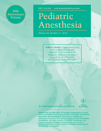Experience with a propofol–ketamine mixture for sedation during pediatric orthopedic surgery
Section Editor: Adrian Bosenberg
Summary
Background: Various combinations of propofol and ketofol have been described for the provision of procedural sedation in both adults and children. Utilization of ‘ketofol’ for deep sedation during prolonged pediatric orthopedic procedures has not previously been described.
Methods: During an orthopedic aid trip, a 1:1 mixture of propofol and ketamine (200 mg of each drawn up to 22 ml) was utilized to provide deep sedation or general anesthesia as an adjunct to regional analgesia for lower limb surgery. Details for 18 patients having a total of 19 procedures were recorded with a record of intraoperative and postoperative parameters including initial bolus doses and infusion rates of ketofol required to produce deep sedation.
Results: Mean operating time was 153.7 min (range 64–241 min). The mean initial bolus dose of ketofol was 0.19 ml·kg−1 (range 0.1–0.5 ml·kg−1) or 1.7 mg·kg−1 each of propofol and ketamine (range 0.9–4.5 mg·kg−1). The mean upper limit of the infusion rate required to maintain deep sedation was 0.19 ml·kg−1·h−1 (range 0.07–0.26 ml·kg−1·h−1) or 1.7 mg·kg−1·h−1 (range 0.6–2.4 mg·kg−1·h−1) and the mean lower limit of the infusion rate was 0.08 ml·kg−1·h−1 (range 0.02–0.13 ml·kg−1·h−1) or 0.7 mg·kg−1·h−1 (range 0.2–1.2 mg·kg−1·h−1). The mean initial bolus dose of ketofol was 0.19 ml·kg−1 (range 0.1–0.5 ml·kg−1). There were no episodes of hypo- or hypertension or of desaturation. Mean time to eye opening after infusion cessation was 5.1 min (median 2 min; range 0–17 min).
Conclusion: Ketofol successfully produced deep sedation for prolonged pediatric orthopedic procedures in conjunction with regional analgesia. Further research to confirm its safety and applicability to a wider range of settings is required.




